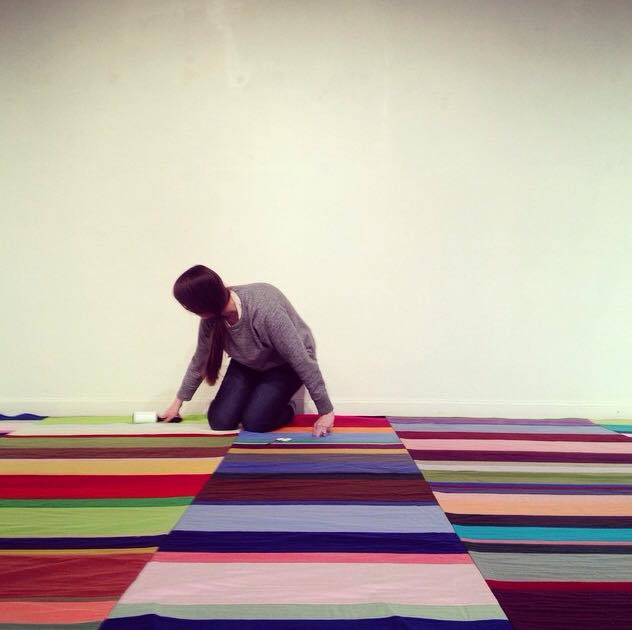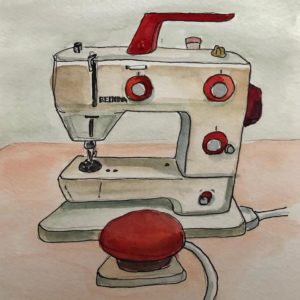
How did you get started sewing?
I never touched a sewing machine until I was 24 or 25, married and in living in Savannah GA. My husband had bought a bunch of fabric for a project he was working on (for school). We didn’t have a lot of money but I said that he could buy the fabric, on the condition that I could turn it into something. So, I made some curtains – and I did everything wrong. I was winding the bobbin by hand, and using my mom’s old sewing machine with no manual. I enjoyed it, I actually did get some functional curtains out of it and then I decided I wanted to make a quilt.
I had a niece that was born and I was designing her quilt in the Home Depot break room when someone mentioned that there was a quilt store around the corner. I had only ever shopped at JoAnn’s but I went to the quilt store which sold Bernina sewing machines. It was maybe the second or third time I was in there that I impulse-bought a Bernina. And that was pretty much what changed things for me. When I bought that machine, the store became my resource and those southern women became my teachers and that’s how I learned how to sew.
In 2008 we moved back to KC and the economy crashed. I was doing freelance design and decided I needed a part-time job. I was taking my machine in to be serviced and asked if they needed part-time help. I got a job working in the Bernina store and stayed there for 7 years.
What do you think it was about the act of sewing that intrigued you. Do you think it had anything to do with your architectural background?
I’m glad you phrased it that way, because I think the skill set is the same – it is an analytical creative process. And I like to know how things work. I figure out efficiencies, how to do things in a system and work methodically. I think sewing, whether it is quilting or garment sewing, lends itself to that kind of brain – where you pick a project apart and can start to understand the pieces and the way things work. It’s very inspiring to me that I can continue to learn and grow in both a creative and also a technical way.
Who are your creative influences?
I recently finished an MFA in textiles where I did a lot with quilting, but often what I was more interested in while making artwork was the process. I like to really dig deep into understanding how things are done. I did a study abroad in Japan and went to Awagami paper factory and learned how to make paper – from literally the very beginning of the process. The only thing we didn’t do was chop down the plant. We took the Kozo sticks, we boiled them, we scraped the bark off them, and we beat them into a pulp. We took the pulp and pulled and dried the sheets. That Japanese idea of how you become a master paper maker – there are people who devote their whole lives to understanding the entire ins and outs of the process and that to me is pretty inspirational. When I can get projects to come full circle and I can understand the beginning and ending part of the process it is really exciting to me. That’s not necessarily a person, it’s just an idea. Or a way of living that inspires the way that I operate.
As a garment seamstress how do you create your projects? Do you make variations on patterns?
In my experience of working with people sewing garments there are two kind of camps of sewers. There are people like me who like to follow the pattern and learn how to specifically alter and make the pattern fit. I’m pretty good about doing that for myself with my own body. But then there is the other type of person who is like “I have this thing that I want to make it into this other thing and I’m just going to trace this garment off and make a pattern from it” – they sort of wing it and Frankenstein patterns together. I struggle with that because I am more on the analytical side. I want there to be an exact solution. I’m always kind of pushing myself to be more forgiving and more creative with my approach and not so specific about following a certain set rule. I learn from people that I work with that have more of that creative freedom and approach. And I can do it when I help them, and then I’m shocked that I’ve been able to be in their world in that way.
What happens when you make your hobby your job? Does it lose its luster?
I think I stumbled into sewing as a hobby and then stumbled into it as my job. I feel like I’m meant to be here. Sewing was my weekend hobby that I enjoyed but because of the change in economy I started focusing on my sewing job and the freelance design work dropped off. So now my hobby is DIY’ing my house – and my job has become what was my hobby. While I was working in the (Bernina) store I felt like the hobby aspect was still there. Now, as a professional educator for Bernina I have a little more separation of church and state. I travel for my job a lot, which doesn’t allow for a lot of sewing, so I sew less. I find myself now seeking things that are more portable or are something new to learn. I picked up knitting and I find that it works better for me as a way to unwind.

What has been the biggest challenge to making a living as a creative?
It’s hard sometimes for people to understand the value of creative capital. You have to constantly keep that in check and not let people take advantage of that. There is value in your creative ideas and skills that sometimes people don’t recognize. If someone actually wants you to make them something and you start to dissect your time, especially if it is something that involves a creative aspect, by the time you end up charging them what would be fair for the investment of your time and creative energy it is a lot more than they think.
Do you find yourself comparing your projects/career with others that you see on social media?
I think it’s pretty easy to fall into that but I feel like I’m somehow removed from it. I don’t know that anybody is looking at my Instagram account and I don’t care. I have two of them, I have one that is Bernina-related and I have one that is me, my dog and house, and I do it as a way to journal for myself to look back. I’m always shocked with the things that people notice and when they say the love following my Instagram. I just try to be positive online – I think a lot of people can be caught up in the negativity.
Where do you want to see your career in five years?
That’s something we are always thinking about and I feel like I’m always getting it wrong. I love Bernina the brand and that is a very genuine thing for me because it comes from a personal experience. I don’t really see what I’m doing for my job now as a stepping stone to something else in the industry. If in five years I can be doing something more amazing for Bernina – I don’t know what that looks like or how that evolves. I don’t look at the corporate structure or job titles and think “Oh, I would make a really great district manager or marketing director.” I feel like I could do any of those things – I just try to be open to the idea of possibilities. I think that is pretty much how I’ve ended up here. To be a creative person and find a creative job requires a certain amount of resiliency and willingness to try and fail and figure it out and reinvent. I’m always thinking maybe I could do that, or maybe I’ll try that. Who knows maybe in five years I’ll be working in this bakery and making really awesome bread*. That is probably just as likely as anything else. I do love Bernina and I’d like to stick with them. I guess the ideal dream job is that I would be in Switzerland inventing the next big sewing machine – that would be cool.
What are you working on currently?
There are a lot of really exciting things coming up with Bernina. My focus is on sergers and I’ve been heavily involved with that process. We’ve been doing some fun social media videos which I’ve been able to be a part of. I just had an experience sewing swimwear for the first time, so I spent a good month and a half focusing on that. It was fun – it’s exciting when you sew something super challenging and it’s not as hard as you think. Other than that, I’m pretty happy to be growing grass in my front yard. We’ve planted a new tree and I’m getting ready to rip out the last little bit of carpet in the house and put down some flooring and finish a little home project
What are a few things you recommend people to check out?
I just got off a sailboat and I recommend – if you can – to go do something that puts you outside your element. I’m not a big fan of water, but this is our fourth time doing this sailing trip and when you are surrounded by water it’s actually very beautiful and serene and exciting to camp on a sailboat. It’s like camping on the ocean.
My friends, who are a Bernina dealers as well, have a craft store in Virginia, which sells a subscription box called Finch Box for either sewing or knitting. You get the box every other month. For me, the knitting box has been great because they are pretty simple projects and you get the supplies and the directions. It’s given me something to do every time.
